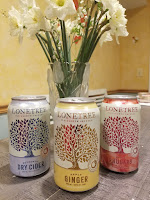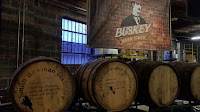
This is a big month for Virginia Cider. Last week the
American Cider Association (ACA) announced the launch of the
Virginia Cider Trail where users of the app can win prizes and receive discounts at participating cider houses. And it just happened that this summer I have already visited four of these establishments. And I believe I was the first to officially check-in using the Virginia Cider Trail app at Sage Bird Ciderworks and Ciders from Mars.

In addition, our partner site at
BevFluence has opened brand registration today for their
Cider: New Perspectives on Cider, Perry, and Brandy campaign. The cider, perry, and brandy products will be presented to a combination of industry experts, mixologists, bartenders, creators, bloggers, writers, and other media – and across the craft beverage landscape. This will generate new perspectives about cider, perry, and apple brandy from creators who range from cider novices to experts. I also plan on taking the ACA's Certified Cider Professional (CCP) exam during this campaign and using the ciders with my training guide. Brands and content creators can register
here for the BevFluence campaign or learn more about the CCP
here.
Lost Boy Cider is an urban cidery in Alexandria and sources its fruit from various orchards in the Shenandoah Valley. In early June they hosted one of four sessions on the
Virginia Cider Road Show presented by the ACA. After a brief overview of Lost Boy by cidermaker Dave, the ACA's Jennie Dorsey provided a history of cider, a history of cider in North America, and then the history of cider in Virginia. She then provided a brief overview of Virginia's three most important apple varieties: Newton (Albemarle) Pippin, Hewes VA Crab, and Harrison. She finished by discussing the ACA's Apple classes (bittersweet, bittersharp, sweet, & sharp); ACA Cider Families (cider, perry, fruit cider, botanical cider, & dessert ciders); cider cocktails; and cider-food pairings. Yes, a boatload of information was packed within each session. We finished with a food and cider pairing featuring cheeses from Cheestique. I think the Barrel-Aged cider paired with the Appalachian cheese, dried pear, and balsamic vinegar was my favorite -- very complimentary.
 Castle Hill Cider
Castle Hill Cider is located east of Charlottesville in Keswick and has an interesting history regarding the propagation of cider apples. As stated on their website:
Colonel Thomas Walker, the original owner of Castle Hill Estate, was the first to bring Newtown Pippin apple scions to Central Virginia following his return from the Battle of Brandywine in 1777. The variety was planted at Castle Hill and became known as the Albemarle Pippin apple.

And as most Virginia cider lovers know, the Albemarle Pippin is still one of the signature Virginia apple varieties and was even exported to England throughout the 1800s. Castle Hill Cider was founded in 2020 and the estate is planted with 6,500 trees featuring more than 30 apple varieties including Albemarle Pippin, Black Twig, Harrison, Burford Red Fresh, GoldRush, Dabinett, Hewes Crab, and Wickson Crab. The ciders are bottled in either 750ml or 375ml bottles and range from sweet to dry.
During our visit, we choose a Classic flight and a Barrel aged flight. The majority of the group preferred the Terrestrial 2020 where the tannins and slight RS are balanced. It's also an interesting blend that includes Black Twig, Winesap, and Ashmead's Kernel. Personally, I preferred the funky, dry, and naturally fermented in quevri Levity 2020. Is this the only American cider fermented and aged in Georgian quevri?
For the barrel-aged ciders, the Hewes Pommeau Reserve is fascinating with complexity created by four years of aging in Woodford Reserve barrels and Keswick Winery wine puncheons. I also enjoyed the Silver Bough where Dabinett and Golden Hornet ciders were aged over a year in rum barrels.
 Sage Bird Ciderworks
Sage Bird Ciderworks is located in downtown Harrisonburg and opened a couple years ago after the persistently hard work of Zach and Amberlee Carlson. This is the first cidery in the home of the Dukes and they offer an excellent array of various styles. I settled on a flight of five ciders - slightly more than the paddle size. The clear favorite was the
Dry River Reserve -- their flagship brut cider made from a blend of Virginia-grown apples. The
Peaches For Me fits perfectly into the upcoming BevFluence campaign since the cider was aged in used apple brandy barrels. The oak treatment is noticeable -- providing a peaches and cream feel with a boost of apple flavors. Finally, an interesting geographic cider is their
Stay Gold, a dry cider inspired by West Virginia's official state fruit, the famed Golden Delicious apple.
 Ciders from Mars
Ciders from Mars is located about 30 miles south in downtown Stanton across the street from both
Ox Eye Vineyards and
Redbeard Brewing Company. So no excuses for not visiting. The cidery was founded by Virginia natives and science-minded Nikki West and Jeremy Wimpey. And Nikki improved her cidermaking through courses at the
Cider Institute of North America -> a partner of the American Cider Association. Over a burger from
1Tribe Farm, I sampled six ciders through a standard flight. The
Helles Dry is a solid representation of a brut cider and on the other side of the spectrum, the
Pink Oceans was interesting with a subtle strawberry profile. However, the most impressive cider was easily the
Liquid Gang, made from foraged apples and fermented using native yeast. The tannic structure mimics biting into an apple. Could be my favorite cider made in Virginia and is on par with the excellent cider from New York's
Aaron Burr Cidery.
 Perhaps our favorite craft beverage stop during our Quebec visit was to Les Vergers Lafrance, a multifaceted establishment located just outside of Saint-Joseph-du-Lac. This municipality is surrounded by panoramic mountain views, orchards, and a truly rustic countryside. LaFrance participates in providing these orchards with their 30 hectares of 13,000 apple trees, 4,000 grape vines, 500 pear trees and 250 plum trees. And the apple trees are distributed among 20 different apple varieties. Besides les vergers, LaFrance is a cidery, winery, distillery, maple producer, and restaurateurs.
Perhaps our favorite craft beverage stop during our Quebec visit was to Les Vergers Lafrance, a multifaceted establishment located just outside of Saint-Joseph-du-Lac. This municipality is surrounded by panoramic mountain views, orchards, and a truly rustic countryside. LaFrance participates in providing these orchards with their 30 hectares of 13,000 apple trees, 4,000 grape vines, 500 pear trees and 250 plum trees. And the apple trees are distributed among 20 different apple varieties. Besides les vergers, LaFrance is a cidery, winery, distillery, maple producer, and restaurateurs. Vignoble Lafrance is composed of more than 4,000 grapevines, particularly all shades of Frontenac and Sabrevois -- both cold climate grapes bred at the University of Minnesota. LaFrance uses the grapes exclusively for the production of spirits. One of these is their Dandy Gin which is a fruit distillate made from apple, pear and grape eau-de-vie as well as our Marc de Raisins eau-de-vie. The botanicals consist of selected herbs and apple tree flowers from the estate orchards. Need less to say, this gin is quite floral, with less juniper but more citrus.
Vignoble Lafrance is composed of more than 4,000 grapevines, particularly all shades of Frontenac and Sabrevois -- both cold climate grapes bred at the University of Minnesota. LaFrance uses the grapes exclusively for the production of spirits. One of these is their Dandy Gin which is a fruit distillate made from apple, pear and grape eau-de-vie as well as our Marc de Raisins eau-de-vie. The botanicals consist of selected herbs and apple tree flowers from the estate orchards. Need less to say, this gin is quite floral, with less juniper but more citrus.  The distilling operation started in 2013, when Domaine Lafrance acquired an alembic still made in Bordeaux by the Stupfler family. This family has been producing stills for four generations starting in 1925. Lafrance produces almost a dozen spirits and aperitifs as well as a range of ready to drink cocktails. We also purchased a bottle of the Quartier Lafrance - a Grand Marnier inspired spirit made from 50% Georges-Étienne apple brandy and 50% caramelized orange liqueur. Try to beef up are cocktail options with this surprisingly drier and complex liqueur.
The distilling operation started in 2013, when Domaine Lafrance acquired an alembic still made in Bordeaux by the Stupfler family. This family has been producing stills for four generations starting in 1925. Lafrance produces almost a dozen spirits and aperitifs as well as a range of ready to drink cocktails. We also purchased a bottle of the Quartier Lafrance - a Grand Marnier inspired spirit made from 50% Georges-Étienne apple brandy and 50% caramelized orange liqueur. Try to beef up are cocktail options with this surprisingly drier and complex liqueur. Despite all these endeavors, the prime focus of the enterprise is cider where they produce close to 20 different cider products. This includes the canned Bio Sparkling Organic Cider and Bio Organic Rosé Cider that complemented the suddenly sunny afternoon picnicking in front of the Boutique. Another easy option was the canned Darragon dit Lafrance sparkling cider. And please try the Rick Special blend #3, an unfiltered sparkling brut cider that was fermented in ice cider barrels. We didn't sample any of the still ciders, but had to bring home a miniature of the Domaine LaFrance Ice Cider. I would have brought full 375ml bottles of all their ice ciders, but was leery of crossing the border with a weeks worth of cider and beer. These are elegant ice ciders.
Despite all these endeavors, the prime focus of the enterprise is cider where they produce close to 20 different cider products. This includes the canned Bio Sparkling Organic Cider and Bio Organic Rosé Cider that complemented the suddenly sunny afternoon picnicking in front of the Boutique. Another easy option was the canned Darragon dit Lafrance sparkling cider. And please try the Rick Special blend #3, an unfiltered sparkling brut cider that was fermented in ice cider barrels. We didn't sample any of the still ciders, but had to bring home a miniature of the Domaine LaFrance Ice Cider. I would have brought full 375ml bottles of all their ice ciders, but was leery of crossing the border with a weeks worth of cider and beer. These are elegant ice ciders. 















































